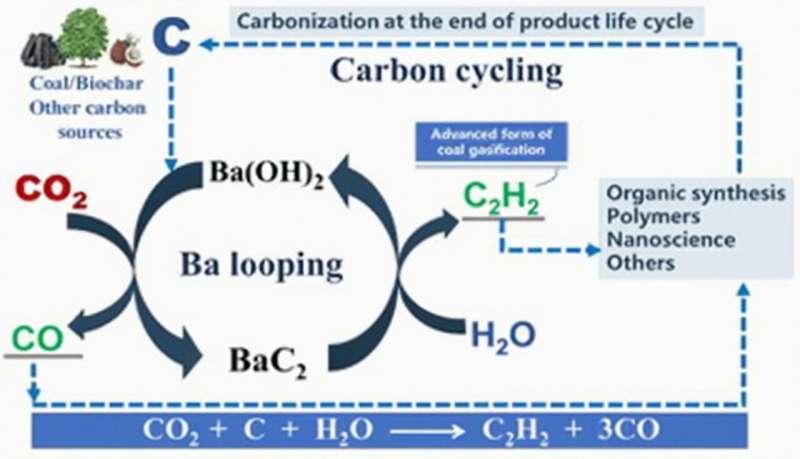This article has been reviewed according to Science X's editorial process and policies. Editors have highlighted the following attributes while ensuring the content's credibility:
fact-checked
peer-reviewed publication
trusted source
proofread
Novel sustainable coupling technology proposed for carbon-to-acetylene process

The carbide-based carbon-to-acetylene (C2H2) process is a simple pathway to convert various sources of carbon into acetylene and carbon monoxide directly. However, the current industrial process based on calcium carbide (CaC2) is restricted by high energy consumption, significant amount of carbon dioxide and industrial solid waste emission.
Recently, a research team led by Prof. Zhao Hong and Prof. Jiang Biao from the Shanghai Advanced Research Institute of the Chinese Academy of Sciences has proposed a sustainable acetylene and carbon monoxide coproducing process based on BaCO3-BaC2-Ba(OH)2-BaCO3 barium cycle, which can simultaneously realize CO2 capture and acetylene-carbon monoxide co-production at mild dynamic conditions with lower energy consumption and less waste emission.
The results were published in Green Chemistry on Aug. 16.
The researchers found that BaC2 could be efficiently solid-phase synthesized at about 1,500°C by using carbon and BaCO3 as raw materials without CO2 emission, which is more than 600°C lower than the production temperature of CaC2.
In addition, Ba(OH)2 produced by the gasification of calcium carbide into acetylene was easily recovered and converted into BaCO3 by absorbing CO2, which was then used to synthesize carbide, verifying the coupling process between carbon-to-acetylene and carbon dioxide capture based on Ba loop, reducing the waste of carbide slag.
The results suggested that BaC2 was the more suitable intermediate for carbon-to-acetylene process than CaC2, because of the milder formation temperature, the faster reaction rate, and the more convenient barium recover to carbide production.
Featuring low cost, less wastes and high efficiency of co-producing of acetylene and carbon monoxide, this technology is expected to synthesize various of chemicals by using C2H2 and CO as platform chemicals instead of CO and H2 produced by carbon gasification.
More information: Miao Li et al, Reengineering of the carbon-to-acetylene process featuring negative carbon emission, Green Chemistry (2023). DOI: 10.1039/D3GC01775C
Journal information: Green Chemistry
Provided by Chinese Academy of Sciences





















